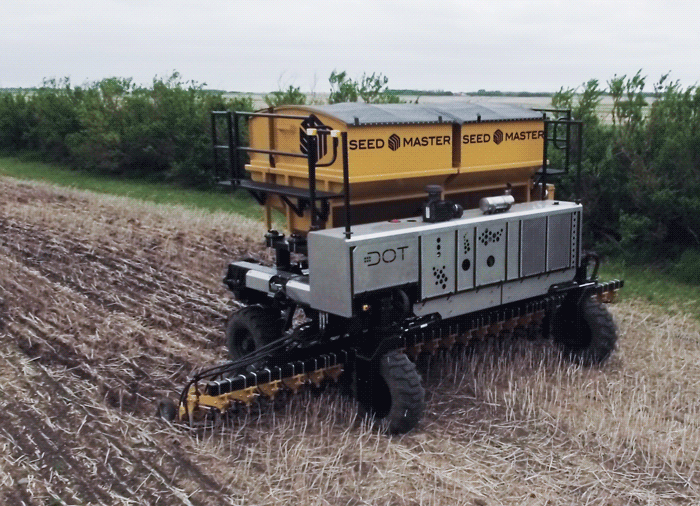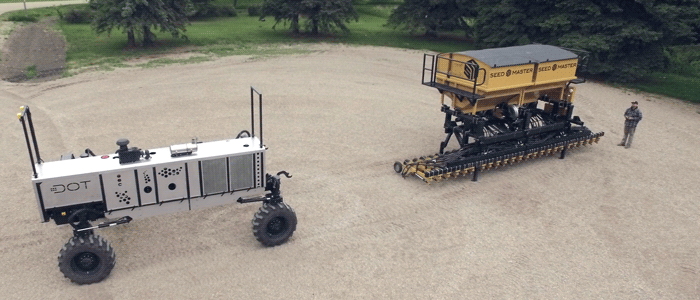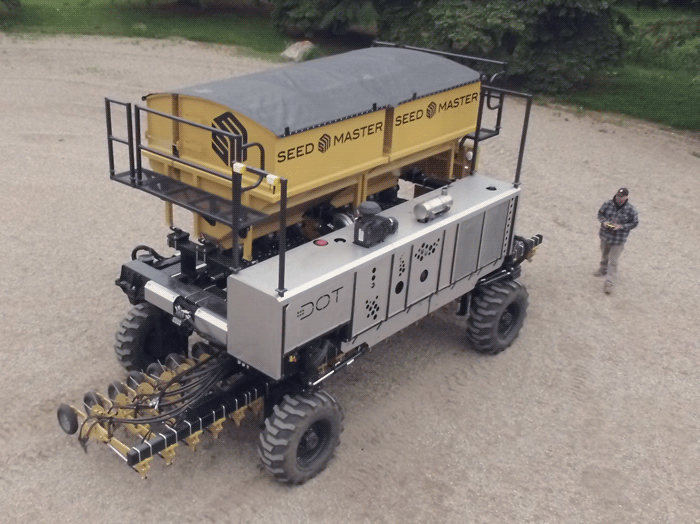As the reality of autonomous farm equipment draws ever
closer, the shape of farm equipment is changing radically.
One of the latest concepts that will see half a dozen prototypes in the field in southern Canada this summer drops all pretense of traditional traction tractor appearance with its cabless U-shaped frame and 4 steerable hydraulic-powered wheels.
Developed by DOT Technology Corp., Emerald Park, Sask., the DOT power platforms are currently designed to work in the field autonomously with a number of implements ranging from a 30-foot air seeder, a 60-foot sprayer with 1,000-gallon tank, a 41-foot land roller for pulse crop production, and a 500-bushel grain cart.
The concept has been eagerly accepted by growers introduced to it at last year’s Ag In Motion outdoor demonstration farm show near Saskatoon, and by technical committees at AgriTechnica in Hanover, Germany, last November.
Cory Beaujot, whose family owns DOT Technology Corp., and whose father Norbert designed the DOT system, says additional implements will be developed as demand warrants, and as collaborating shortline manufacturers begin building equipment to function with the DOT units.

In the field, whether spraying, rolling, planting or hustling grain carts, the DOT units are capable of field speeds up to 12 mph and feature several redundant fail safe options in case the machine veers off course or encounters obstacles.
“Earlier this year we launched a deposit program in which interested growers can put down $1,000 as a deposit for a DOT built between 2019 and 2022,” he explains. “We see our market area as Canada and the U.S., Australia and Europe, so we may have to shift production around a bit based on where the orders originate. We are very encouraged by the response to the program.
“Also, we’ve recently forged a relationship with a manufacturer of larger sprayers and a coulter side-dressing implement for corn, and their marketing sights are set farther south (the U.S. Corn Belt) than our original strategy called for. That also could have an effect on how and where our production will be aimed.”
DOT’s marketing specialist Marco Coppola says the power platforms will be built by DOT’s sister company SeedMaster Mfg., which has the capacity to produce 300-500 units per year but will take a couple of years to ramp up to that level of demand.

In the farmyard, the diesel-powered DOT power platform, left, is guided by remote control to the DOT-ready seeder where it will be linked to the seeder by heavy-duty linkages and steel dowels
Beaujot says despite the advanced sensors, processors and other electronics on board, the assembly of the DOT’s power platform is relatively simple as it consists of a heavy-duty frame, a 175 horsepower, Tier 4 Cummins diesel engine and hydraulic pump, 4 steerable wheels and hydraulic motors for each.
The machines are equipped with an 85-gallon fuel tank and can operate up to 12 mph.
To use the DOT, a grower would use a remote control handset to guide the machine to the DOT-ready implement. The implement fits within the “U” of the DOT’s frame and is lifted by four heavy-duty linkages where it is pinned in place for use.
Once in the field, the DOT uses GPS positioning to follow maps programmed into its processor and is controlled by a tablet human-to-machine interface. The tablet display gives the operator real-time engine operating conditions and access through an ISOBUS connection to communicate with the implement.

Once married together, the DOT power platform and seeder are ready for transport to the field where the machine will follow pre-existing field maps to plant the crop.
“Growers can use pre-existing field maps, or they can drive around the field recording field dimensions and obstacles. Once those measurements are taken, creating a field map takes only minutes and the machine can be on its way,” Beaujot explains.
A number of fail safe features are built into to the DOT to stop it if it veers from its predetermined path, or if it encounters an obstacle along the way.
Beaujot says the machines are designed to cover the same land mass in a day as a good size traditional combine — regardless of the implement being used — to enable them to fit into existing farming work schedules.
Once production of commercially available units begins, Beaujot says emission requirements will probably mandate an engine in the 200 horsepower range as early as 2019.
Beaujot says the DOT offers enhanced productivity through the use of one power platform for many implements and field chores, efficient use of power through effective weight transference of the power platform (12,500 pounds dry weight) and the implement, and significantly reduced maintenance and labor requirements






